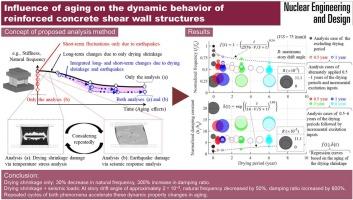老化对钢筋混凝土剪力墙结构动力性能的影响
IF 2.1
3区 工程技术
Q1 NUCLEAR SCIENCE & TECHNOLOGY
引用次数: 0
摘要
核电厂用钢筋混凝土建筑在建成后,随着时间的推移,其固有频率逐渐降低,这主要是由于混凝土在干燥过程中会发生收缩,地震力对其造成的破坏较小。本文提出了一种综合考虑干燥收缩力和地震力的数值分析方法,并研究了它们的影响。采用该方法进行的有限元模拟结果表明,当只考虑混凝土的干燥收缩时,当最终收缩应变率达到95%时,混凝土的固有频率降低了30%,阻尼常数增加了300%。此外,在短期地震力作用下,固有频率降低50%,阻尼常数增加600%,导致层间漂移角约为2 × 10-3。经证实,这些变化随着干燥收缩和地震力的反复施加而加速。通过将考虑了由于累积干燥期导致的刚度和阻尼老化的简化模拟与有限元模拟进行比较,地震响应可以等效地评估到大约2 × 10-3的层漂移角,而与有限元模拟相比,超过此范围的响应被高估,允许保守评估。这项工作具有实际用途,因为它能够在复杂建模和基于当前设计规范的简化方法之间架起桥梁。研究结果有助于建立地震安全评价方法,充分考虑老化对长期使用的钢筋混凝土结构的影响。本文章由计算机程序翻译,如有差异,请以英文原文为准。

Influence of aging on the dynamic behavior of reinforced concrete shear wall structures
The natural frequency of reinforced concrete buildings for nuclear power plants gradually decreases over time after their completion, mainly because of the shrinkage of the concrete during drying and minor damage caused by seismic forces. In this study, a numerical analysis method that comprehensively considers both drying shrinkage and seismic forces and investigates their effects is proposed. The results of finite element (FE) simulations performed with the proposed method show that when only the drying shrinkage of concrete is considered, the natural frequency decreases by 30 % and the damping constant increases by 300 % when the final shrinkage strain rate reaches 95 %. Furthermore, the natural frequency decreases by 50 % and the damping constant increases by 600 % when short-term seismic forces are applied, causing story drift angles of approximately 2 × 10–3. It was confirmed that these changes accelerate with repeated application of drying shrinkage and seismic forces. By comparing simplified simulations that consider the aging of stiffness and damping due to cumulative drying periods with FE simulations, seismic responses can be equivalently evaluated up to story drift angles of approximately 2 × 10–3, while responses beyond this are overestimated compared to FE simulation, allowing for conservative evaluations. This work has practical usefulness in that it enables bridging between complex modeling and simplified methods based on current design codes. The findings contribute to the establishment of seismic safety evaluation methods that adequately account for the effects of aging on reinforced concrete structures used over long periods of time.
求助全文
通过发布文献求助,成功后即可免费获取论文全文。
去求助
来源期刊

Nuclear Engineering and Design
工程技术-核科学技术
CiteScore
3.40
自引率
11.80%
发文量
377
审稿时长
5 months
期刊介绍:
Nuclear Engineering and Design covers the wide range of disciplines involved in the engineering, design, safety and construction of nuclear fission reactors. The Editors welcome papers both on applied and innovative aspects and developments in nuclear science and technology.
Fundamentals of Reactor Design include:
• Thermal-Hydraulics and Core Physics
• Safety Analysis, Risk Assessment (PSA)
• Structural and Mechanical Engineering
• Materials Science
• Fuel Behavior and Design
• Structural Plant Design
• Engineering of Reactor Components
• Experiments
Aspects beyond fundamentals of Reactor Design covered:
• Accident Mitigation Measures
• Reactor Control Systems
• Licensing Issues
• Safeguard Engineering
• Economy of Plants
• Reprocessing / Waste Disposal
• Applications of Nuclear Energy
• Maintenance
• Decommissioning
Papers on new reactor ideas and developments (Generation IV reactors) such as inherently safe modular HTRs, High Performance LWRs/HWRs and LMFBs/GFR will be considered; Actinide Burners, Accelerator Driven Systems, Energy Amplifiers and other special designs of power and research reactors and their applications are also encouraged.
 求助内容:
求助内容: 应助结果提醒方式:
应助结果提醒方式:


